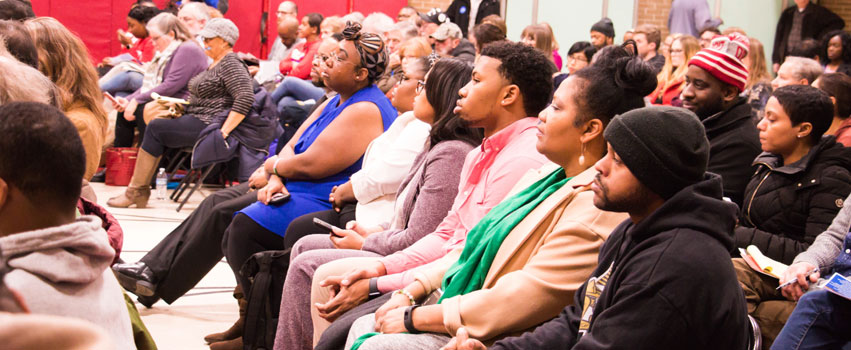Heartbreaker.
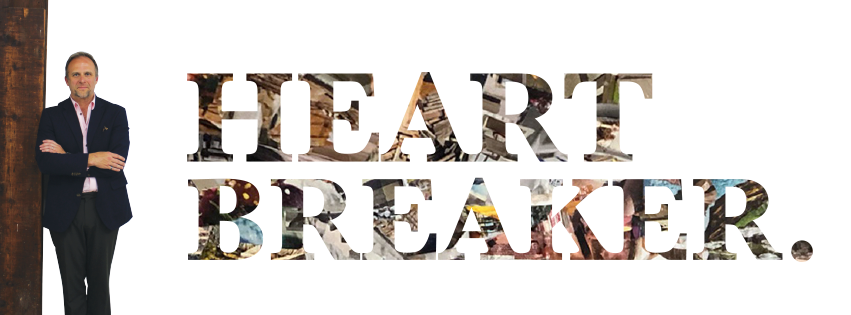
Deep within Peoria’s Warehouse District, a four-story brick building looms at the corner of SW Washington and Persimmon streets. Besides housing Whiskey City Architectural Salvage and Wheel Art Pottery Studios, “The Mill” is home to the studios of numerous local artists—many having migrated there after vacating the Murray Building several years ago. I arrive on a Friday night; according to Facebook, there is an exhibit opening.
Glancing down at my phone, the details are sparse: an event title (“Peripheries”), hours and a street address. A Facebook page, cryptically titled “Heartbreaker.______,” is listed as the host.
Despite a few cars parked out back, there are no obvious signs of people gathering. Circling to the front of the building, I hope to find a clue that might point me in the right direction. Walking down the sidewalk is artist Jessica Bingham, who smiles and waves. She gestures in the opposite direction, toward the back of the building. “Keep going,” she explains.
I turn around and retrace my steps. This time I notice a door that is slightly ajar. My mind registers absurdity—I cannot recall the last time I had to work so hard to find a gallery. Yet I feel a sense of adventure; a genuine curiosity to discover why someone would put together an exhibit that’s so difficult to locate. Entering the building, I walk down a short hallway and turn a corner, guided by the low murmur of laughter and voices. There it is: Heartbreaker, the gallery hidden in plain sight.
A Contradictory Model
“I essentially spent my entire life here,” says Bill Conger, taking a sip of his martini. “I can viscerally remember when Peoria did not really care that it had art.” It’s the Monday after the gallery opening at Heartbreaker. Conger has just finished up his day at the Peoria Riverfront Museum, where he’s been Curator of Collections and Exhibitions for just over two years.
On the surface, the position might seem an unconventional fit for someone who spent his life in the higher echelons of academia and art. Conger worked at Illinois State University for over a decade as both senior curator and as a faculty member. As an artist, he is known for working with found objects and materials, which he then recontextualizes in gallery settings. For years his approach to art was far from inclusive—less by choice than as a result of his environment. In the public eye, his work likely seemed unapproachable. But stepping into his current role at the museum, he saw an opportunity. “This was a job that made sense to me because I really want to see change,” he points out.
By day, Conger’s impact at the museum is readily visible, but his other work is not—his approach to impacting Peoria’s art scene is purposefully surreptitious. Just before he began working at the museum, he opened Heartbreaker—the elusive gallery inside The Mill, where he also has his personal studio. And it is quite unlike the gallery space at the museum.
“The model that I’m working with is just contradictory to what people [typically] do. People advertise—they reach out and bring people in. I’m not doing it that way,” he says with a shrug, as if his reasoning should be obvious. “It really is just this special moment…designed for those who want it.”
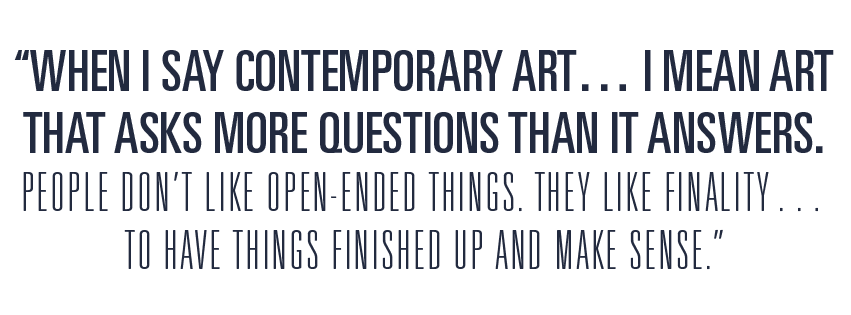
Medium for Discussion
Understanding why Heartbreaker exists requires a look into the context of Conger’s life. Growing up on Peoria’s East Bluff, he was an only child—“and I wasn’t the greatest child,” he adds with a knowing smirk. Art was something he could depend upon—in good times and bad. “When this world opened up to me, it was an escape. This is how I can be who I am supposed to be.”
His earliest artistic pursuits centered around music, but that changed in college. Conger excelled at breaking free of rigor and rules, but in a calculated and strategic sense—which he found easiest to do in a studio. “I’m good at taking something in the world and making it a surrogate that we can connect to emotionally,” he suggests. For instance, he began to make paintings using old house paints that had been relegated to the dollar shelf. “It was going to be thrown away if someone didn’t come buy it,” he recalls. “The throwaway house paint… salvage it and reconstitute it into something meaningful.”
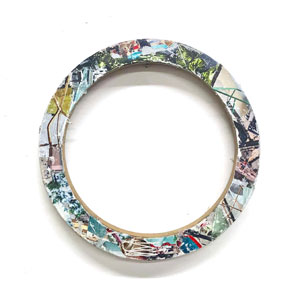
His work often feels strangely nostalgic. While the found objects are familiar, they appear to be out of place… almost suspended in time. Conger, who was adopted, feels this to his core. “I think the found object and adoption, for me, are similar… There is this idea that you are not going away. It isn’t refuse,” he declares. “And it reinstitutes some kind of importance into it… if you have to get really Freudian and metaphorical about it,” he adds with a wry smile.
Back at Heartbreaker, it is obvious the gallery is informed by Conger’s own work—even as the works of other artists hang on the walls. It is a white cube, a neutral space, sterile and unobtrusive. It’s an intimate venue—a purposeful choice. “In a small space, even with just five people in it, you have discussion, you have communication, you have an exchange of ideas,” he points out. “If there are two strangers in there with you, you kind of have to indulge a conversation. You’re almost forced to.”
Conger wants these conversations to take place on both a micro and a macro scale—to that end, he feels passionately about bringing in contemporary art from outside of the area. “Outside art is about seeing what other people in the world are thinking and how they’re reacting to their craft. And when I say ‘contemporary art,’ I don’t just mean people who are alive; I mean art that asks more questions than it answers. Scary!” he reflects, laughing. “People don’t like open-ended things. They like finality…
to have things finished up and make sense.”
As a teacher, Conger worked to help his students understand the concept of art without judgment. He didn’t care if they liked the artwork he introduced them to—he just wanted them to agree that it was art. “That’s a big hurdle, just trying to break those things down slowly to have a discussion. And those discussions, at the end of the day, don’t have anything to do with art. They have to do with going out into the world being more accepting, more curious and more imaginative,” he clarifies. “Art is just a medium to kind of help that along.”
He views Heartbreaker as a catalyst that helps people feel more at ease with not always understanding what they see. “I hope they feel comfortable enough… that they can be okay not liking it and still having fun with it. It’s letting go of some of those preconceptions of what we think art should do for us.”
And who is invited to the discussion? Conger admits that Heartbreaker might feel exclusive, but nothing could be further from the truth. “The gallery, the opening, the artist… part of that implies that you should be in the ‘club.’ I’m trying to suggest that the club is ever-changing. Everyone is invited all the time,” he suggests. “Open that pathway that is imagination, and that is spiritual… let it in and don’t apologize for what you don’t know.”
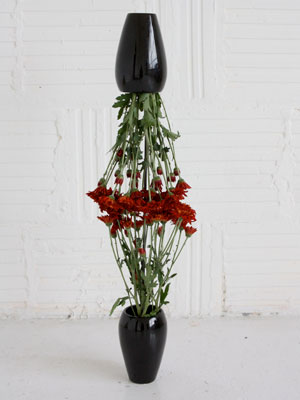
Reclaiming Community
The name “Heartbreaker” is derived from Fort Crèvecoeur, the 17th-century fort erected near present-day Creve Coeur—the first fort built by the French in Illinois. “Crève-coeur means ‘broken heart,’” Conger explains. “There is a story that the portion of land they built it on resembles a heart, but the French would use that name often. It almost signifies a sadness or, and this is my opinion, kind of a predetermination.”
Heartbreaker, he continues, is about all the questions our community may not always ask. “It’s like art. We’re not asking, we’re not open, we’re not curious enough to know. And I want our community to know that there’s something to be curious about,” he says, disclosing his affection for local Peoria history. “That doesn’t just end with distilleries, brothels and gangs—it goes way farther.”
Over the years, Conger has watched several false starts within Peoria’s art scene—but he believes we are now in the midst of true growth. “I think we have to be honest about what we have been, what we are and what we need to be… If I’m guilty of anything, I’m guilty of being honest about what I think the community can benefit from,” he says, chuckling. “Something about change here is frightening. I’m not exactly sure why that is… but I think it is changing. I think it is actually happening beneath our feet.”
Asked about his continued passion for Heartbreaker, Conger pauses. “The one thing I’ve been good at my entire life is getting excited. Art does that for me, and it has since I was running around… like that,” he smiles, motioning toward a young child nearby. “It’s a little sad that people go through their lives not experiencing that. So, play, imagination, openness… is really what I think art is about.”
As we finish our drinks, Conger muses that perhaps Heartbreaker will lose its power to challenge the community if it becomes part of the mainstream art circuit.
“It’s still going to be weird,” I offer.
“Good! I’m glad to hear that,” he laughs. “I’ve done my job, then.” PM
